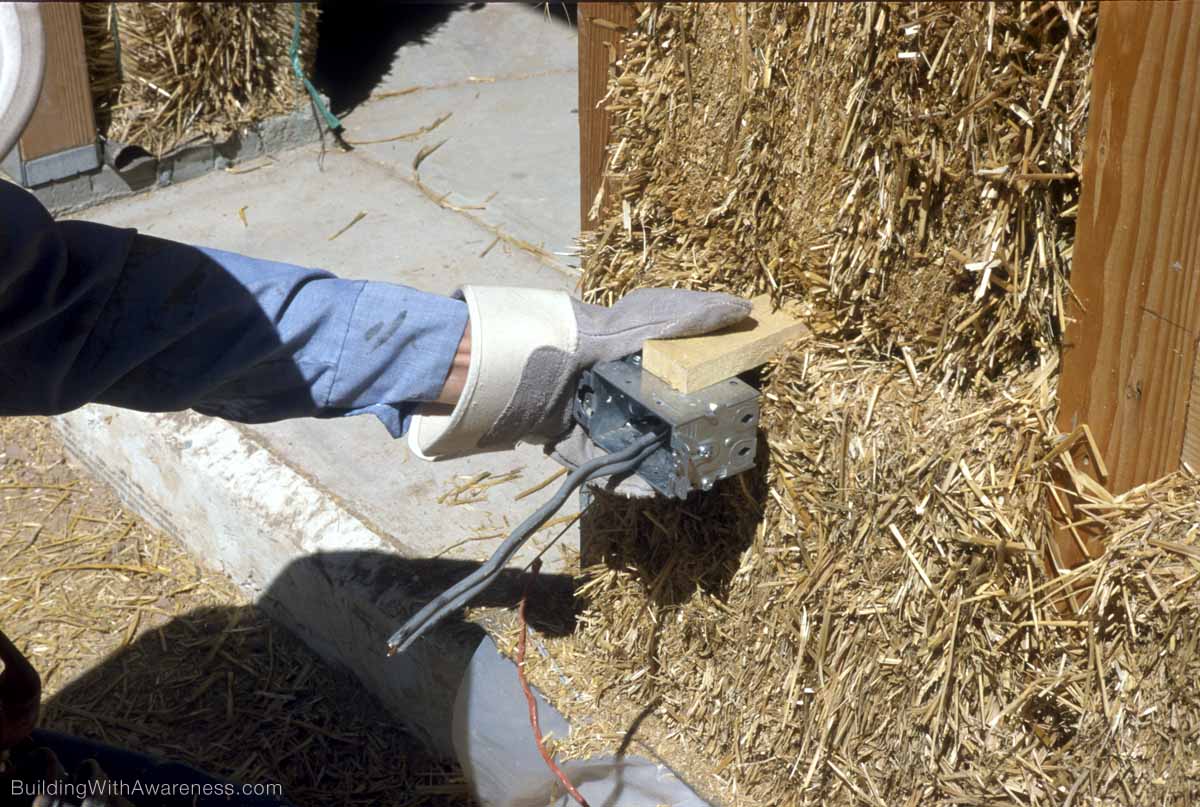The straw bales are now in place, and it is time to complete the rough-in of the electrical wiring for the home featured in Building With Awareness. In order to meet code requirements, an electrician is hired for this procedure. As I mentioned in a previous article, some of the wiring for the house had been placed within the adobe walls while the bricks were being laid. For the straw bale walls, a chainsaw is used to cut one-and-a-half-inch deep channels into the bales. The electrical wire is pushed into these notches and run to the electrical outlets and switches in each room. The wire can also be pushed into the seams between the bales. The end of a blunt wooden stake can be used to push the wire into the notches or the bale seams. The wire used here is called UF cable, which stands for Underground Feeder. This is a very durable and moisture-resistant wire that is designed to be buried underground. When a wire must pass from the inside to the outside of a bale wall, it is fastened with tape to a long needle or rod made from one- quarter-inch-diameter metal. It is pushed through the bale, the tape removed, and the needle pulled out, leaving only the wire in place.
When wire is being run through ceilings and frame walls—not adobe or straw bale—Romex cable can be used. Romex cable is somewhat more flexible than UF cable, and is therefore easier to work with.
The boxes for electrical plugs and switches are made out of either plastic or metal. We used metal boxes for durability and for the ease of ganging multiple boxes together. A long wooden stake is secured to the box with screws and then pushed into the bale like a large spike. Some straw must be cut away where the box is recessed into the bale. Before the box is pushed securely into place, the electrical wire is threaded into the unit from the rear. The front edges of the boxes are kept at least one inch away from the surface of the straw bales, to allow for the thickness of earth plaster and/or gypsum plaster that will be applied to the surfaces of the walls at a later date.
Every wire in the house will wind its way through the walls and ceiling to the main circuit breaker box. Wiring will also run to electrical switches and ceiling and wall light fixtures. Even though this home generates all of its own electricity using the photovoltaic panels on the roof, all the AC
electrical wiring—from the circuit-breaker box to the wall plugs—is identical to that of a conventionally-powered home.
If you are using recessed light canisters in the ceiling, make sure they can < accomodate compact fluorescent bulbs, which will make the home much more efficient in terms of energy use. You may also want to install wiring for ceiling fans, since they use only a fraction of the electricity that an air conditioner uses, and can keep a room quite comfortable just by circulating the air.
As we complete the electrical wiring of the house, we will also be installing
phone cable, TV cable, and thermostat wiring.
See Chapter 8 of the Building With Awareness DVD and book for detailed information on how to wire a straw bale home.
-Ted Owens
